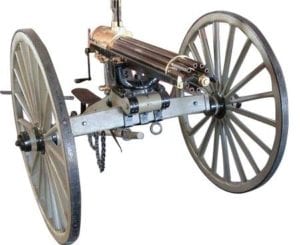Imagine a gun so powerful an airplane was designed around it. A gun whose trademark “BRRRT” it emits when fired brings relief to U.S. ground forces and terror to their enemies. A gun with so much firepower it slows the aircraft when fired. This is the GAU-8/A Avenger, the foremost representation of the Gatling gun. But where did such a beast of a cannon come from? And what about its connection to the Fairchild Republic A-10 “Thunderbolt II” (or Warthog, as it’s often lovingly called)?
Origin of the Gatling Gun
In the 19th Century, warfare was typically defined by men standing in straight lines, courteously waiting for each other to slowly and methodically reload their flint and stock muskets before firing alternating volleys. In short, madness.
Enter Richard Jordan Gatling. The doctor had grown tired of warfare and its incredible costliness in terms of wasted resources and lives. He designed a multi-barreled, rotating, crank-operated gun that would go on to forever change the face of the battlefield. And in 1861, around the beginning of the American Civil War, Gatling presented his invention to the Union Forces.
The first Gatling gun featured eight, manually-cranked, rotating barrels and was built onto a wheeled cart. As the operator turned the crank, a round entered the barrel from a magazine before rotating to the firing position. Once fired, the barrel continued on its journey and was again reloaded, allowing a high volume of rounds to be fired in a short amount of time.

The first iteration was limited in the number of rounds it could fire per minute, but with the invention of brass-cartridge-style ammunition, later versions were capable of firing up to 400 rounds per minute.
By comparison, a well-trained musketeer could load and fire up to five rounds in a minute. This new invention could indeed, theoretically, replace an army of men.
While a valiant effort, the physician’s first design was flawed. It easily jammed and was incredibly cumbersome, limiting the mobility that’s key to victory in any battle.
Among others, limitations in materials and ammunition rendered the Gatling gun to the “basement” of military weaponry. The concept of using multiple barrels to quickly fire high volumes of rounds fell out of popularity around the early 20th Century.
The Rise of the Minigun
Following World War II, the Gatling gun was reincarnated in the form of the “minigun.” The original concept of utilizing multiple spinning barrels to fire a barrage of bullets was bolstered by the addition of an electric motor and belt-fed ammunition. Gone were the days of a laborious, slow process of driving a hand crank and manually replacing limited magazines. Also, with the use of lightweight materials, sluggish, cumbersome versions that placed their operators in imminent danger of enemy fire were a thing of the past.
These modern forms of the Gatling gun are marked by an electrically powered motor that can drive the mechanism and fire up to 6,000 rounds per minute. Such weapons are used throughout the U.S. military. The M61 Vulcan is carried by virtually every modern American fighter aircraft. And they can be found on everything from small landing craft, such as those used by the Navy SEALS or armored personal carriers (Army Humvee), to transport helicopters (Army UH-1 Huey) and as point defense systems on our Navy fleets and overseas military bases in heavily contested regions.
The Mighty Fairchild A-10 “Thunderbolt II”
The Fairchild A-10 “Thunderbolt II” was built around its forward-mounted Gatling gun. The A-10s primary armament is the GAU-8/A Avenger, one of the most intimidating forms of the Gatling gun the world has ever witnessed. The aircraft was developed in the ‘60s as a close air support fighter bomber, specifically envisioned to fight off waves of heavy Russian tanks. The gun can fire 4,200 rounds per minute, but typically only fires in two-second bursts—enough to deliver 100 rounds at 1,200 meters. And the A-10 can hold up to 1,350 rounds of 30mm ammunition. In essence, this is all more than enough to fulfill the A-10s promise as a “tank buster.” The gun is so big, in fact, that the aircraft’s front landing gear is offset to accommodate the weapon and its voluminous ammunition drum.
For your chance to see the Fairchild A-10 “Thunderbolt II,” and its gun, up close and personal, visit the Hill Aerospace Museum today. We are home to more than 70 modern and vintage military aircraft. We also proudly feature thousands of artifacts representing the history of aviation. With free admission, it’s hard to find a reason not to visit! Contact us or visit our FAQs page for answers to your questions. And follow us on Facebook for updates and more military aircraft information!

